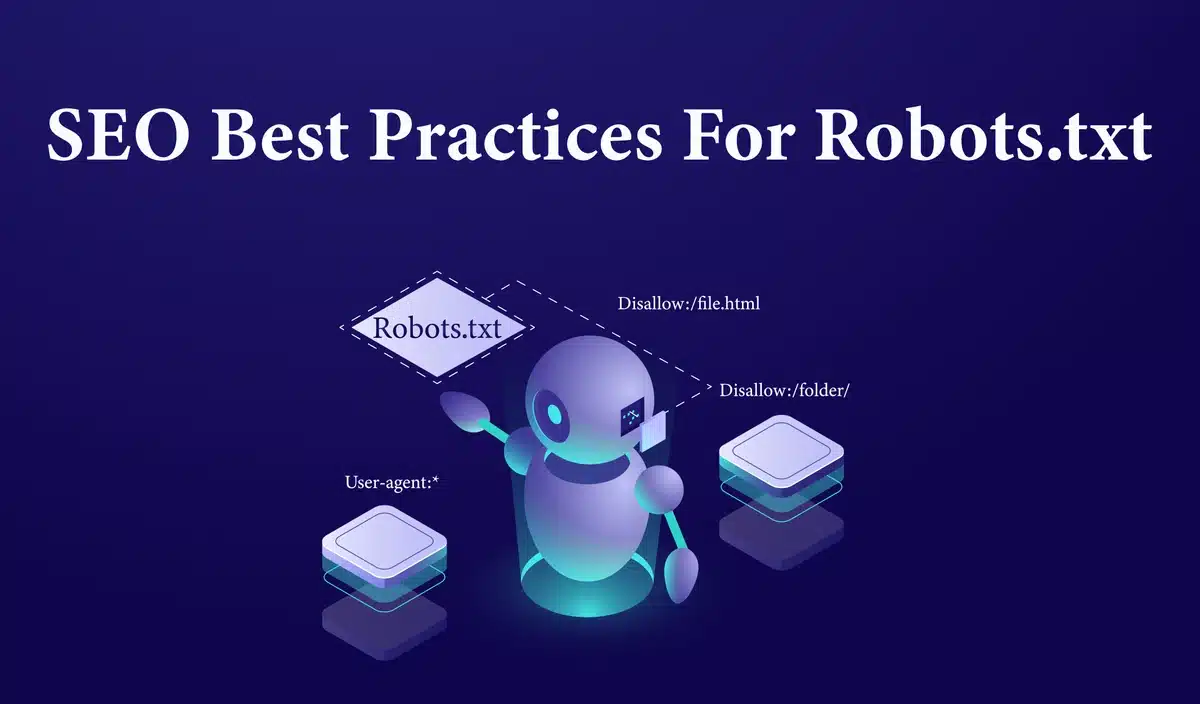Robots.txt: The Complete Guide to Optimizing Your Website for Search Engines

October 2, 2025
/
Robots.txt: The Complete Guide to Optimizing Your Website for Search Engines
In the world of SEO, one of the most overlooked yet powerful tools is the robots.txt file. Whether you run a personal blog, an e-commerce store, or a large corporate website in the Middle East or beyond, understanding how robots.txt works can dramatically improve your site’s visibility and performance in search engines.
This article will walk you through what is robots.txt , why it matters, how to create and optimize it, and the most common mistakes businesses make.
What is Robots.txt?
The robots.txt file is a small but powerful text file placed in the root directory of your website that communicates directly with search engine crawlers like Googlebot and Bingbot. Its primary role is to specify which pages, directories, or resources should be accessible for crawling and which ones should remain restricted. By setting these rules, website owners can guide search engines on how to interact with their site, making the robots.txt file a fundamental element in technical SEO. In practice, robots.txt helps prevent unnecessary or sensitive pages—such as admin dashboards, duplicate content, or internal scripts—from being indexed. While it doesn’t guarantee complete privacy, it acts as the first line of defense to control website indexing. When used correctly, it improves crawl efficiency, ensuring that search engines focus on the most valuable and SEO-friendly content. This makes the robots.txt file an essential tool for optimizing your site’s visibility and improving overall search engine optimization (SEO) performance.Why Robots.txt Matters for SEO
The robots.txt file plays a vital role in SEO because it directly influences how search engines interact with your website. By controlling which pages can be crawled, you ensure that search engines focus their resources on indexing your most valuable and relevant content. This process not only improves your site’s visibility but also prevents low-quality or duplicate pages from negatively affecting your rankings.Control Search Engine Crawling
A properly configured robots.txt file gives you the power to control search engine crawling across your website. By setting specific rules, you decide which areas of your site should be accessible and which should remain hidden. This allows search engines to prioritize the right content without wasting time on irrelevant or low-value pages. For example, you may want to block search engines from crawling internal search results, duplicate content, or staging environments. These pages add little to no SEO value and can confuse both search engines and users if indexed. By managing crawling efficiently, you protect your website from unnecessary exposure. Effective control over crawling ensures that Google bots and other crawlers focus only on your best-performing pages. This leads to improved website indexing, better rankings, and a stronger foundation for your overall SEO strategy.Improve Crawl Efficiency
Crawl efficiency is crucial because search engines allocate a limited crawl budget to every website. With robots.txt, you can guide bots to spend that budget wisely by crawling only the most valuable and relevant pages. This helps maximize visibility where it matters most. When search engines waste time crawling unimportant or restricted areas, your important content risks being overlooked. By improving crawl efficiency, you ensure that high-quality pages are indexed faster and given more attention in search results. This is especially important for large websites with thousands of pages. In short, the robots.txt file helps optimize crawl allocation, boosting your chances of ranking higher on search engines. It acts as a roadmap for bots, directing them toward pages that align with your SEO objectives and overall business goals.Protect Sensitive Information
One of the most valuable functions of the robots.txt file is its ability to protect sensitive information. By blocking crawlers from accessing admin areas, login pages, or private directories, you ensure that critical data is not accidentally indexed by search engines. Although robots.txt is not a security feature in itself, it acts as a preventative measure against exposing unnecessary or confidential pages to the public. This is especially important for eCommerce sites, membership platforms, and businesses handling private user information. By preventing these sections from appearing in search engine results, you not only reduce risks but also maintain a professional and clean website presence. Keeping sensitive content hidden helps build trust with both users and search engines.Enhance User Experience
The ultimate goal of SEO is to provide the best user experience, and robots.txt contributes to this objective. By guiding crawlers to prioritize high-quality, relevant content, you ensure that users find the information they’re searching for quickly and easily. When irrelevant or duplicate pages appear in search results, it frustrates users and reduces your site’s credibility. Robots.txt prevents this by ensuring that only valuable pages are indexed and displayed, improving both user satisfaction and search performance. A well-optimized robots.txt file creates a smoother navigation flow, eliminates clutter in search results, and enhances overall content visibility. As a result, your website becomes more user-friendly and better positioned for long-term SEO success.How Robots.txt Works
- Allow: Grants access to certain pages or directories.
- Disallow: Prevents crawlers from accessing specific sections.
- Sitemap Declaration: Points search engines to your sitemap for easier indexing.
Common Uses of Robots.txt
- Blocking duplicate content (e.g., print-friendly versions of articles).
- Restricting crawlers from admin pages or login portals.
- Allowing full access to the main site while blocking unnecessary directories.
- Guiding crawlers to sitemaps for faster and smarter indexing.
SEO Best Practices for Robots.txt
Optimizing your robots.txt file ensures that search engines crawl and index your website efficiently. By following best practices, you can protect sensitive areas, improve crawl budget, and boost overall SEO performance.Always Include a Sitemap URL
Adding your XML sitemap in the robots.txt file helps search engines discover and index your content more efficiently. This ensures that all your important pages are crawled without missing out on valuable sections of your site. ✅ Example: User-agent: * Disallow: Sitemap: https://www.example.com/sitemap.xml This tells Google, Bing, and other bots exactly where to find your sitemap, making crawling and indexing much smoother.Disallow Low-Value Pages
Certain pages, like shopping cart, checkout, or admin areas, don’t add SEO value and shouldn’t appear in search engine results. Blocking them with robots.txt keeps your crawl budget focused on valuable content. ✅ Example: User-agent: * Disallow: /cart/ Disallow: /checkout/ Disallow: /wp-admin/ Here, common low-value pages such as cart and checkout are restricted from crawling.Don’t Block Important Content
One of the biggest mistakes is accidentally blocking your main content such as blog posts, product pages, or service pages. These sections drive organic traffic and should always remain crawlable. ❌ Bad Example (Never Do This): User-agent: * Disallow: /blog/ Disallow: /products/ ✅ Correct Example: User-agent: * Disallow: /admin/ Disallow: /private/ # Keep important pages open Allow: /blog/ Allow: /products/ This ensures your money pages (blog, products, services) remain indexable.Keep the File Simple
Overcomplicated robots.txt rules can confuse both crawlers and developers. Keep your file short, clear, and structured. A simple file reduces the risk of blocking important content by mistake. ✅ Simple Example: User-agent: * Disallow: /temp/ Disallow: /drafts/ Sitemap: https://www.example.com/sitemap.xml This format is clean, easy to understand, and effective for SEO management.Test Before You Launch
Before making robots.txt live, always test it in Google Search Console. This ensures that your rules are working correctly and you’re not unintentionally blocking important pages. 🔍 How to Test:- Go to Google Search Console → "Robots.txt Tester".
- Paste your robots.txt rules.
- Enter a page URL and test whether it’s being blocked or allowed.
- Run tests after every change.
- Monitor indexing regularly in Google Search Console.
Robots.txt for the Middle East Market
Websites in the Middle East often face challenges such as:- Multilingual SEO: Arabic, English, and sometimes French content. Robots.txt helps guide crawlers to avoid duplicate indexing across languages.
- Regional Hosting Issues: Ensuring crawlers don’t waste time on server-side scripts.
- E-commerce Growth: With booming online shopping, it’s crucial to prevent crawlers from indexing duplicate product filters and parameters.
Common Mistakes to Avoid
Misconfiguring your robots.txt file can hurt website indexing and SEO performance. Avoid these common errors to ensure that search engines crawl the right pages and your site maintains strong visibility.Blocking the Entire Website by Accident
One of the most common robots.txt mistakes is accidentally blocking the entire website. This usually happens when developers use a Disallow: / directive during development and forget to remove it before going live. Such an error prevents search engine crawlers from indexing any page on your site. When this happens, even your most valuable pages—like product listings, blog posts, or service pages—disappear from search results. As a result, your website loses visibility, traffic, and potential customers. To avoid this, always double-check your robots.txt file after deployment. Make sure that only unnecessary sections are blocked, while all important content remains crawlable for SEO performance.Forgetting to Update the File After Launching New Sections
Another mistake is forgetting to update the robots.txt file when you add new sections or features to your website. For example, if you launch a new blog, category, or product section, search engines may struggle to find and index it if the file is outdated. This can lead to missed opportunities, as valuable new content may not appear in search results. Over time, this directly affects your SEO strategy, reducing your chances of ranking for new keywords. To fix this, make it a habit to review and update your robots.txt file whenever you expand your site. A fresh and accurate file ensures that Google bots and Bing bots can crawl and index new pages effectively.Not Submitting a Sitemap in the Robots.txt File
Many site owners forget to include a link to their XML sitemap in the robots.txt file. This is a missed opportunity because a sitemap helps search engines crawl and index your site more efficiently. Without it, bots may overlook important pages or crawl your website in a less structured way. Submitting a sitemap via robots.txt ensures that search engines have a roadmap of all your key pages. This improves crawl coverage and supports faster indexing of newly published content. For best SEO results, always add your sitemap URL to the robots.txt file. This simple step strengthens your overall technical SEO and enhances website visibility.Overusing the Disallow Function and Hiding Valuable Content
Some website owners make the mistake of overusing the Disallow directive in robots.txt. While it’s useful for blocking low-value pages, applying it too broadly can unintentionally hide valuable content, such as blogs, service pages, or product categories. When search engines are prevented from crawling these sections, your site loses out on organic traffic. This can harm keyword rankings, reduce visibility, and create gaps in your SEO performance. Instead of blocking aggressively, adopt a balanced approach. Disallow only the pages that truly don’t add value, and keep your most important content fully accessible to search engine crawlers.How to Create a Robots.txt File
Creating a robots.txt file is easy:- Open a simple text editor (like Notepad).
- Add your rules (allow, disallow, sitemap link).
- Save the file as robots.txt.
- Upload it to the root directory of your website (e.g., www.yourdomain.com/robots.txt).
How to Conduct a Robots.txt Audit
- Check Existing File – Review your current robots.txt setup.
- Identify Key Pages – Make sure your most important pages are crawlable.
- Block Irrelevant Sections – Hide admin, duplicate, or irrelevant URLs.
- Submit to Google Search Console – Validate and monitor performance.
- Regular Updates – Update the file whenever your site structure changes.
Conclusion
The robots.txt file is more than just a technical document—it’s a strategic SEO asset. When used correctly, it improves crawl efficiency, protects sensitive areas, and ensures that your high-value content gets the visibility it deserves.Frequently Asked Questions (FAQs)
- What happens if I don’t have a robots.txt file? Search engines will crawl your entire site by default, which may not be ideal.
- Can robots.txt improve my SEO rankings? Indirectly, yes. It doesn’t boost rankings directly, but it ensures that crawlers spend time on your most important content.
- Should I block my login and admin pages? Yes, these don’t need to appear in search results and should be disallowed.
- How do I know if my robots.txt file is correct? Use tools like Google Search Console or online robots.txt checkers to validate it.
- What is the difference between sitemap and robots.txt? The sitemap shows search engines what to crawl, while robots.txt tells them what not to crawl.
- Can robots.txt hide private data completely? No. Robots.txt is only a guideline for crawlers, not a security tool. Sensitive data should be protected with passwords or server settings.
Call to Action
Are you ready to optimize your website for both search engines and users? Our team can help you audit, create, and optimize your robots.txt file, ensuring your site ranks higher across the Middle East and global markets. Contact us today to take control of your website’s SEO performance!Recent Posts
ahmed/0 Comments
SWOT Analysis for Marketing
ahmed/0 Comments
SEO Audit: The Ultimate Guide to Perfecting Your Website Performance
ahmed/0 Comments




